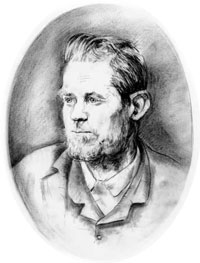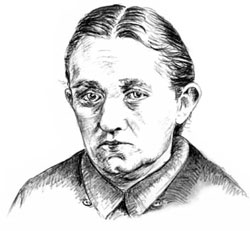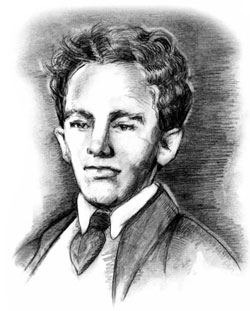Crime Time: Australians Behaving Badly (6 page)
Read Crime Time: Australians Behaving Badly Online
Authors: Sue Bursztynski
Tags: #Children's Books, #Education & Reference, #Law & Crime, #Geography & Cultures, #Explore the World, #Australia & Oceania, #Children's eBooks

FREDERICK DEEMING
P
retty Kate Rounsefell had just arrived in Melbourne by train. She was looking forward to travelling on to Western Australia, where she was going to join her fiancé, Albert Williams. She had met him on the ship from Melbourne to Sydney and he had swept her off her feet.
As she stepped off the train, she was handed a telegram from her sister, Elizabeth. Police had told Elizabeth the truth about her fiancé. His name wasn’t Albert Williams, or Baron Swanston as he had claimed to others, it was Frederick Deeming – and he was wanted for the murders of his wives and children. Even the engagement ring she was wearing had belonged to Emily, the wife he’d left hidden under the fireplace of their home in the Melbourne suburb of Windsor.
This was 1892. Elizabeth couldn’t email Kate or ring her on a mobile phone. She could only hope that one of the four telegrams she sent would reach Kate. Luckily, one had.
The investigation began when the owner of a house in Windsor checked out a horrible smell from a bedroom. His tenant, a Mr Druin, had gone. The smell came from the rotting body of a woman whose throat had been cut and who had been shoved under the fireplace. Police found papers that belonged to a Mr Albert Williams and his wife Emily, who had arrived in Australia a year ago.
Clearly, Albert Williams was Mr Druin. Investigators also traced him to Western Australia, where he had gone under the name of Baron Swanston. He was living in a small town called Southern Cross. Deeming was arrested and brought back to Melbourne to stand trial.
Now, the whole horrible story came out. Frederick Deeming and his wife Marie had come from England in 1881, settling in the Sydney suburb of Balmain. They had two children, who went back with them to England when Deeming had to escape some debts. There, they had two more children. He’d been going by the name of Albert Williams at the time and another piece of paper found in Windsor told police where he had been living in England: Rainhill, a village near Liverpool.
The editor of the
Argus
, a Melbourne newspaper, decided this might make a good story. He contacted the newspaper’s London journalist and asked him to go to Rainhill, to see what he could find out.
The journalist spoke to the mother of Emily Mather, who had gone to Australia with Albert Williams and never returned. Mrs Mather said there was a house he had rented in the area. He had never lived there, staying at a hotel instead. Perhaps there would be something interesting at the house.
Liverpool police were indeed very interested. They found the bodies of Marie and her four children. Unfortunately, Deeming couldn’t be tried for their murders in Australia, but he would be tried for Emily’s murder.
Nobody can say he wasn’t given a fair trial. He had a very good lawyer, a barrister called Alfred Deakin, who would one day be the Prime Minister of Australia. Deakin tried to prove that Deeming had been insane at the time of the murders. It didn’t work, even though Deeming tried to prove his own insanity by telling the government doctor, Dr Shield, that his dead mother had told him to commit all those murders.

Just before his sentencing, he demanded that the court get on with it. He’d been kept waiting for four days, he complained, and he’d been in court since ten o’clock that morning. He wanted to be released, now! And he’d had about enough of that ugly bunch of jurors.
The jury obliged him. They did get on with their decision, finding him guilty of Emily’s murder. On a cold morning in May, he gulped down his last glass of brandy and was hanged at the Old Melbourne Gaol, on the same gallows as Ned Kelly.

DID YOU KNOW…?
Most people who have heard of Redmond Barry only know him as the judge who sentenced Ned Kelly to death. In fact, he did a lot more than that for the city of Melbourne. He founded Melbourne University, the State Library and Museum of Victoria. Before there was a public library, he let people come to his house to read his own books. He gave much of his income to the poor. Even as a judge, he had a reputation for not being too hard on those he convicted – except, perhaps, for poor Ned Kelly.
JOHN AND SARAH MAKIN
ALL IN THE BABY-FARMING FAMILY
T
he Makins seemed like such a nice couple. They had four children of their own living with them, Florence, Clarice, Blanche and Daisy. When eighteen-year-old Amber Murray, unmarried mother of a little boy called Horace, first met them in 1892, she just knew the kindly couple would be the perfect foster parents for her child.
Amber had put an ad in the
Sydney Morning Herald,
asking for a kind, motherly person to adopt her little boy. She was willing to pay for this. She received a letter from a Mr and Mrs Makin in the Sydney suburb of Redfern, who said they had lost their own little boy and would be thrilled to take care of hers for ten shillings a week. They promised that her son would ‘receive a mother’s love and attention’.
When she arrived at their home, she found that they were baby farmers, looking after several other children. But the young mother hadn’t heard about what some baby farmers got up to. And they must be all right, because they didn’t have any problem with her wish to visit her child often. They even told her that they would be moving soon, to a place called Hurstville.

Somehow, the Makins managed to collect money from Amber weekly, while not letting her see her baby. They couldn’t let her see him, of course. He was dead and buried in their garden. When they did move – as they had to, with all those little bodies buried in the backyard – it was to a suburb called Macdonaldtown, not to Hurstville.
They did take some babies with them, but of course, poor little Horace wasn’t among them. John Makin took a baby for a visit to Amber’s address. It had sores all over its face so perhaps she wouldn’t have been suspicious even if she’d been at home. As it was, only her landlady was there and she had no idea what Horace looked like.
The Makin family left Macdonaldtown after only a few weeks. This was a mistake. When a man came in to install some pipes, he found the bodies of two dead babies. Police soon found five more. And that was only at the Macdonaldtown address. Altogether, the investigators ended up discovering twelve bodies.
The police tracked down the family to a nearby suburb called Chippendale. At this new home, there were no babies. The couple claimed that they had only ever looked after one child, whose parents had taken it back.
Police found several more bodies at the house in Redfern, including Amber Murray’s little boy.
Now, the truth came out. The family was always on the move, going under different names. The Makins’ daughters had known what was going on. The whole family was arrested, which must have been unusual for this kind of crime. The youngest child, Daisy, was only eleven years old.
Witness after witness spoke against John and Sarah Makin, including two of their own children. Clarice Makin said she had left home to work as a servant, but she remembered two babies staying with her parents in Macdonaldtown. She also recognised some clothing from the dead children.
Little Daisy broke down and cried, but agreed that her mother had brought two baby girls to the house in Macdonaldtown.
The evidence against them was very strong. It didn’t take the jury long to find them guilty. John and Sarah Makin were condemned to death. Their daughters were allowed to go free.
On 15 August 1893, John Makin was hanged at Sydney Gaol. Sarah’s life sentence was reduced and she ended up serving a fourteen-year sentence.
She was released in 1911.

SQUIZZY TAYLOR
J
oseph Leslie ‘Squizzy’ Taylor was a thief, blackmailer, drug dealer and many other things, but he spent very little time in prison. His longest sentence was two years, but that was early in his career. Squizzy was very good at persuading witnesses and juries that they would be safer if they didn’t upset him.
Squizzy Taylor was born in 1888 in the seaside town of Brighton, now a suburb of Melbourne. He got a job as an apprentice jockey, but soon found that crime paid much better.
Squizzy joined a gang called the Bourke Street Rats, where he learned his trade, starting with shoplifting and picking pockets. At first he was just fined or got short sentences for his crimes. When finally a judge sentenced him to two years for picking pockets in 1908, he told Squizzy that he was now a confirmed criminal, but Squizzy hadn’t even started.
Squizzy Taylor didn’t like taking risks when he could go for easy targets or get someone else to do the dangerous work. He began with blackmail. Blackmail was easy: you just had to threaten to report people who were doing something illegal and demand that they pay you not to tell the police.
Another crime that paid well was something known as ‘the ginger game’. This was like the trick played, years later, by Jean Lee and her boyfriend. Squizzy would ask his girlfriend or another woman to take a man to a hotel room. Soon afterwards, one of his gang members would burst in pretending to be an angry husband and make the victim pay a large fee if he wanted to avoid a bashing or worse.
These schemes worked well, but weren’t enough for Taylor. Robbery was even better. In 1913, he was almost certainly involved in killing Arthur Trotter, a salesman he and his friends were robbing, but there wasn’t enough proof to convict him.
Three years later, an unlucky cab driver hired by Taylor and a gang member ended up dead because he realised that the equipment they were carrying was for a robbery. Taylor literally got away with murder when three witnesses who swore that they had seen the killing suddenly changed their minds. Squizzy was sentenced on a much lesser charge and only spent a year in prison.

After World War I, the government made a big mistake. Pubs now had to close at 6.00 p.m. sharp. This provided a new source of income for crooks like Squizzy Taylor. ‘Sly grog’ shops sold drinks to people after hours. Squizzy supplied the shops with illegal alcohol and ‘protected’ them. ‘Protection’ meant that they had to pay him not to wreck their businesses. And if the business you were running was illegal anyway, you couldn’t very well complain to the police.
Over the next few years, Squizzy robbed, ‘protected’, dealt in drugs, murdered and even, occasionally, acted as a police informer. This didn’t make him very popular with other criminals.
Some of his gang members went to the gallows, but not Squizzy. He always managed to slide out of trouble. In the end, though, it wasn’t the police who finished him off. It was another criminal.
In 1927, Daniel ‘Snowy’ Cutmore, who had been in Squizzy’s gang before moving to Sydney, returned to Melbourne. Snowy was an enemy now. When he smashed up a business Squizzy was ‘protecting’, Squizzy was very angry. With two of his men, he went to Snowy’s home in Fitzroy. Snowy was sick in bed, but he wasn’t so sick he’d forgotten to protect himself. A gun lay hidden in the bed.
Squizzy and his two men broke into the room. Squizzy shot Snowy. Snowy managed to snatch up his gun and shoot Squizzy before he died. Squizzy staggered from the room and climbed into the waiting taxi. One of his men went with him, but left him before the cab reached St Vincent’s Hospital, where he died. He was buried in the Brighton Cemetery, where his grave can still be seen.

DID YOU KNOW…?
Most people leave money in clothes going into the washing machine. Lewis Moran, father of Melbourne’s criminal Moran family, hid $14,000 in the oven. When someone turned it on, the notes shrank to the size of play-money. Luckily for him, a friend managed to arrange for a bank in Sydney to accept the cash.
